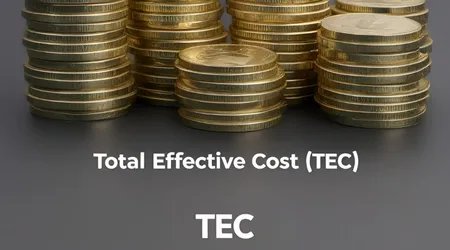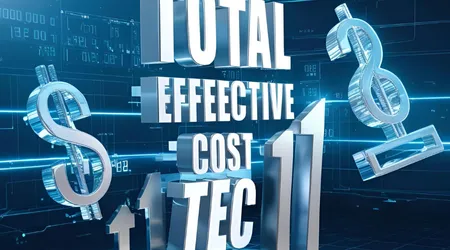Loan Without Knowing the APR?
Advertisements

When you decide to take out a loan, whether to fulfill a dream, pay off a debt, or invest in a project, excitement can overshadow a crucial detail.
In this sense, the Total Effective Cost (CET).
Ignoring the CET is like embarking on a trip without checking the car's fuel level. You may even get somewhere, but the journey could cost much more than expected.
But what really happens when you catch one loan without knowing the CET?
This text explores the consequences, risks, and strategies for avoiding financial traps, with solid arguments, practical examples, and a dash of reflection.
Find out more:
Loan Without Knowing the APR?

The APR is the sum of all costs associated with a loan, including interest, administrative fees, insurance, and other charges.
Unlike the nominal interest rate, which may seem attractive in advertisements, the CET reveals the real impact of the transaction on your pocket.
Therefore, understanding the CET is essential for making informed financial decisions.
Why, then, do so many people neglect this indicator?
The answer lies in the lack of financial education, in the rush for quick solutions and, often, in the lack of transparency in communication between financial institutions.
In this article, we'll dive into the implications of ignoring the CET, with real-life examples, an alarming statistic, and an analogy that illustrates the problem.
Additionally, we'll provide practical tables and a frequently asked questions section to clarify the most common points.
After all, taking out a loan without knowing the APR is like playing chess without knowing the rules: you can move the pieces, but defeat is almost certain.
1. The Consequences of Ignoring the CET

Firstly, when hiring a loan without knowing the CET, you run the risk of paying much more than you planned.
In this sense, the CET is like a magnifying glass that exposes all the hidden costs of a financial transaction.
Without this information, you may be tempted by a seemingly low interest rate, without realizing that additional fees, such as credit opening fees or mandatory insurance, inflate the final value.
For example, a loan of R$ 10,000 with interest of R2% per month may seem reasonable.
But with a CET of 4.5% per month due to extra charges, the real cost doubles in just a few months.
Furthermore, a lack of clarity about the CET can lead to financial mismanagement.
Imagine Ana, an entrepreneur who took out a loan of R$50,000 to expand her business.
Attracted by an interest rate of 1.8% per month, she failed to check the APR, which included a monthly maintenance fee of R$ 200 and insurance of R$ 1,500. Result?
The CET reached 3.2% per month, and Ana had to pay R$ 68,000 over two years, compromising her profit margin.
This example illustrates how the absence of a CET in accounts can turn an investment into a burden.
Finally, ignoring the CET can limit your ability to compare offers.
Different financial institutions have different cost structures, and the CET is the only indicator that standardizes this information.
Therefore, without it, you are at the mercy of misleading advertising.
A 2023 Central Bank survey revealed that 60% of Brazilians who took out loans in the last five years did not know what CET was, which resulted in less advantageous choices.
Therefore, neglecting the CET is not just carelessness – it is giving up control over your finances.
Table:
++ 7 Hidden Functions of Digital Accounts That No One Shows You
| Consequence | Description | Financial Impact |
|---|---|---|
| Unexpected Costs | Undisclosed fees and insurance increase the total loan amount. | Increase of up to 50% in the final cost. |
| Budgetary Mismanagement | Higher installments than planned compromise the monthly budget. | Risk of default or indebtedness. |
| Disadvantageous Choices | The inability to compare offers leads to contracts with worse conditions. | Loss of potential savings. |
2. Why is the CET so relevant?

Firstly, the CET works as a financial map.
Just as a GPS navigation system shows the entire route, including tolls and detours, the CET presents all the costs of a loan in a single metric.
In this sense, this transparency is crucial in a market where financial institutions compete with advertisements that highlight only the most attractive aspects.
For example, a bank may advertise “interest starting at 1% per month,” but the APR, which includes credit analysis and insurance fees, could be 3% or more.
In this sense, knowing the CET allows you to see the complete picture before signing the contract.
Furthermore, CET is an empowerment tool.
It levels the playing field between consumers and financial institutions, which often rely on misinformation to profit.
Consider John, a young man who needed R$ 5,000 to renovate his house.
He received two proposals: one with interest of 1.5% per month and another with 2% per month.
Without checking the CET, João chose the first one, not knowing that it included a registration fee of R$ 300 and insurance of R$ 200, resulting in a CET of 2.8%.
Therefore, the second offer, with a CET of 2.1%, would have been cheaper.
This case shows how the CET can avoid hasty decisions.
Finally, the CET is mandatory by law in Brazil, as regulated by the Central Bank.
Since 2008, financial institutions have been required to inform the CET before signing the contract.
However, many consumers do not require this information, either due to lack of knowledge or in a hurry.
Have you ever stopped to think why some institutions “forget” to highlight the CET in their advertisements?
In short, the answer is simple: the less you know, the more they profit.
Table:
| CET Component | Cost Example | Impact on Loan |
|---|---|---|
| Nominal Interest | 2% per month | Basis of loan cost. |
| Credit Opening Fee | R$ 200 (fixed value) | Increases initial cost. |
| Lender Insurance | R$ 500 (single amount or installments) | It can increase the CET by up to 1% per month. |
| Administrative Fees | R$ 50 monthly | Impacts recurring cost. |
3. How to Avoid Pitfalls When Taking Out a Loan
First of all, financial education is the best defense against the risks of a loan without knowing the CET.
Therefore, start by researching what makes up the CET and how it is calculated.
The Central Bank and Procon websites offer free guides on the topic. Additionally, when negotiating with a bank or financial institution, request written details of the CET.
In this sense, this practice not only protects your rights but also forces the institution to be transparent.
For example, when comparing loans, ask for a spreadsheet with the APR for each offer and analyze the numbers carefully.
Furthermore, another strategy is to use online simulators.
In short, many institutions provide tools that calculate the APR based on the amount, term, and type of loan.
However, they explain how these tools help avoid surprises.
Also, consider consulting a financial planner before taking out a large loan.
A professional can help you interpret the APR and align the loan with your financial goals.
Think of it like hiring a guide before climbing a mountain: the initial investment can save your journey.
Finally, avoid impulsive decisions.
The pressure for quick cash can lead to poor choices, especially in times of crisis.
Before signing, compare at least three offers from different institutions and negotiate additional fees, such as insurance or administrative fees.
In short, remember the chess analogy: every move counts, and a mistake can be costly.
By prioritizing the CET, you transform the loan from a trap into a tool to achieve your goals.
Table:
| Strategy | Benefit | How to Implement |
|---|---|---|
| Require the CET in Writing | Ensures transparency and avoids surprises. | Request the document before signing. |
| Use Online Simulators | Allows you to compare the CET in a practical way. | Access bank websites or platforms like Serasa. |
| Consult a Financial Planner | Offers personalized analysis. | Hire a certified professional. |
4. Loan without Knowing the APR: Frequently Asked Questions
Questions about the APR are common, especially among first-time borrowers.
Below, we've compiled the most frequently asked questions into a clear and informative table, with straightforward answers based on Central Bank regulations.
| Question | Response |
|---|---|
| What is included in the CET? | Interest, administrative fees, insurance, registration fees and other charges. |
| Is the CET the same as the interest rate? | No. The interest rate is only a part of the APR, which includes all costs. |
| Are institutions required to report the CET? | Yes, as regulated by the Central Bank since 2008. |
| Can I negotiate the CET? | Yes, especially fees like insurance and administrative fees. |
| Does the APR vary between loan types? | Yes, personal, payroll, and real estate loans have different APRs. |
Loan Without Knowing the APR: Conclusion
Take a loan without knowing the CET It's like sailing in uncharted waters without a map: you might reach your destination, but the cost of the journey can be exorbitant.
In this sense, from unexpected costs to financial mismanagement, the consequences of ignoring the CET are real and measurable.
However, with information and planning, it is possible to transform the loan into a tool for growth, not a trap.
So, by demanding transparency, comparing offers and using the APR as a guide, you take control of your finances.
The strategies presented, such as research, using simulators, and consulting experts, are practical steps to avoid regrets.
After all, in a world where misinformation is profitable, knowledge is your greatest asset.
So the next time you're considering a loan, ask yourself: Are you ready to play chess with the rules in hand?
